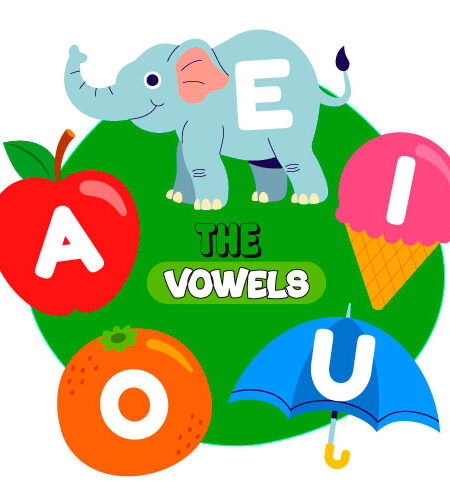Welcome to our exciting journey through the world of vowels! Vowels are the building blocks of the English language, and learning about them can be both fun and educational.
In this post, we will delve into the five English vowels: A, E, I, O, and U, in a creative way. Join us as we discover their sounds and shapes, and don’t forget to record your crayons to color the images we provide!
The Adventurous A:
The vowel A is like an open door to new words. It sounds like “ei” in English. You can find words like “apple” and “airplane” that start with this exciting letter!
Coloring Image: A bright red apple.

The Energetic E:
The vowel E has a sound like “i” in English. Think of words like “elephant” and “egg.” The letter E reminds us of a smile, so smile as you learn!
Coloring Image: A happy-face elephant.

The Ingenious I:
The vowel I sounds like “ai” in English. Words like “ice cream” and “island” start with the letter I. It’s a clever letter that opens the door to imaginative words!
Coloring Image: A sunny island with palm trees.

The Outstanding O:
The vowel O sounds like “ou” in English. Imagine words like “octopus” and “orange.” The letter O has a round shape, just like the sun in the sky!
Coloring Image: A smiling orange.

The Unique U:
The vowel U sounds like “yu” in English. Think of words like “umbrella” and “unicorn.” The letter U has a curved shape, like a rainbow after the rain!
Coloring Image: A beautiful umbrella with a colorful mane.

Vowels play a fundamental role in language and communication.
Here are several reasons highlighting their importance:
- Forming Words:
Vowels, along with consonants, form words. They provide the essential sounds that allow us to distinguish between different words. Changing a vowel sound can completely alter the meaning of a word. For example, the difference between “bit” and “beat” lies in the vowel sound.
- Ensuring Pronunciation:
Vowels often carry the primary stress in a word, indicating how a word is pronounced and helping listeners understand spoken language. Proper pronunciation is crucial for effective communication.
- Facilitating Reading and Writing:
Vowels are the building blocks of written language. Understanding vowels is essential for reading and writing. A strong grasp of vowel sounds aids in decoding words while reading and in spelling words correctly while writing.
- Maintaining Rhythm and Flow:
Vowels contribute to the rhythm and flow of speech. They help in creating syllables, which, in turn, affect the pacing and musicality of spoken language. Different languages and dialects have distinct vowel patterns, contributing to their unique rhythms.
- Distinguishing Languages:
Vowel sounds vary across languages. The presence, absence, and specific pronunciation of vowels are some of the key factors distinguishing one language from another. Learning vowel sounds is essential for language learners to speak and understand different languages accurately.
- Expressing Emotion and Intensity:
Vowel sounds, through intonation and stress, can convey various emotions and intensities in speech. A change in vowel sounds can alter the tone of a sentence, indicating whether it’s a question, statement, or exclamation. This expressive quality is crucial for effective communication in both spoken and written language.
Also color them in a group of balloons

In summary
Vowels are indispensable components of language, shaping how we communicate, express ourselves, and understand the world around us. Understanding their importance is vital for anyone learning a new language or aiming to improve their communication skills.
Feel free to print out these images and let your creativity run wild! Learning vowels has never been this much fun. Happy coloring! 🎨🌟


Comments